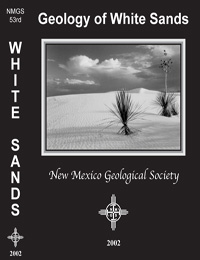New Mexico Geological Society
Fall Field Conference Guidebook - 53
Geology of White Sands

Virgil Lueth, Katherine A. Giles, Spencer G. Lucas, Barry S. Kues, Robert G. Myers, and Dana Ulmer-Scholle, eds, 2002, 362 pages.
In 1942 the ranchers and miners living on the roughly 3200 square mile area that was destined to become White Sands Missile Range, leased their land to the United States Government in order to establish the Alamogordo Bombing Range. On July 9, 1945 Whites Sands Missile Range (WSMR)) was formally established and on July 16 the first atomic bomb was tested at the Trinity Site on the north end of the range. The events of that day would change the course of history for this area in New Mexico and for the entire World. The field trip and guidebook cover an extremely wide range of geologic topics. These topics include a visit to the Proterozoic basement, an overview of nearly the entire Paleozoic, Mesozoic, and Cenozoic stratigraphy, Ancestral Rocky Mountains, Laramide and Rio Grande rift tectonics, coal and mineral deposits, eolian and soil processes of White Sands, and volcanic processes of the anomalously long Carrizozo lava flow. WSMR not only has an incredibly rich geologic history, but the human history of the area has served as the inspiration for many novels, fodder for folklore, and instigation for treasure hunts. In the course of our geologically oriented traverse of the area, we will be fortunate to visit historic sites ranging from the Native Americans who left the petroglyphs that we'll view at Three Rivers, to the testing of the first atomic bomb at the Trinity Site that brought us into the Atomic Age. Our journey across the Tularosa Basin and through Rhodes Canyon and Mockingbird Gap will take us past many structures abandoned by the ranching and milling communities of the past and will trace the rare passages through the San Andres Mountains that were used by the Spanish and early settlers in the region.
Table of Contents:
Note —Downloads of the papers below are free. Road logs, mini-papers, and some other sections of recent guidebooks are only available in print.
Front Matter: (includes Dedication, President's Message, & Conference Organizer's Message)
Download (529 KB PDF)
Roadlogs: (each includes listed mini-papers)
— Spencer G. Lucas, Virgil W. Lueth, Barry S. Kues, Robert G. Myers, and Katherine A. Giles, pp. 1-28. https://doi.org/10.56577/FFC-53.1 [SUMMARY]
Mini-papers:
— Nelia W. Dunbar, pp. 6-8.
— Robert W. Eveleth, pp. 9-10.
— Spencer G. Lucas, pp. 15-16.
— Robert H. Weber, pp. 17-18.
— Steven M. Cather, pp. 21.
— Gretchen K. Hoffman, pp. 21-24.
— Virginia T. McLemore, pp. 26-27.
— Katherine A. Giles, Spencer G. Lucas, Virgil W. Lueth, and Robert G. Myers, pp. 29-51. https://doi.org/10.56577/FFC-53.29 [SUMMARY]
Mini-papers:
— Robert W. Eveleth, pp. 30-32.
— Greg H. Mack, pp. 35.
— Michael C. Pope, pp. 35-36. [ABSTRACT]
— G. S. (Lynn) Soreghan, pp. 39-40.
— Richard P. Langford, pp. 45-47.
— Mark E. Gordon, Gary S. Morgan, and Spencer G. Lucas, pp. 47-48.
— William J. Stone, pp. 49-50.
— Virgil W. Lueth, Spencer G. Lucas, Katherine A. Giles, Barry S. Kues, and James Witcher, pp. 53-73. https://doi.org/10.56577/FFC-53.53 [SUMMARY]
Mini-papers:
— William H. Doleman, pp. 60-62.
Roadlog References:
Download (1.56 MB PDF)
Papers:
— Wayne L. Belzer, Kate C. Miller, and Steven Harder, pp. 79-84. https://doi.org/10.56577/FFC-53.79 [ABSTRACT]
— Steven M. Cather and Richard W. Harrison, pp. 85-101. https://doi.org/10.56577/FFC-53.85 [ABSTRACT]
— Abby W. Howell, Eric A. Erslev, and Steven M. Cather, pp. 103-106. https://doi.org/10.56577/FFC-53.103 [ABSTRACT]
— D. J. Koning and F. J. Pazzaglia, pp. 107-119. https://doi.org/10.56577/FFC-53.107 [ABSTRACT]
— James R. Zimbelman and Andrew K. Johnston, pp. 121-127. https://doi.org/10.56577/FFC-53.121 [ABSTRACT]
— William D. Raatz, pp. 141-157. https://doi.org/10.56577/FFC-53.141 [ABSTRACT]
— Shane C. Seals, Gerilyn S. Soreghan, and R. D. Elmore, pp. 167-177. https://doi.org/10.56577/FFC-53.167 [ABSTRACT]
— Spencer G. Lucas, Karl Krainer, and Barry S. Kues, pp. 179-192. https://doi.org/10.56577/FFC-53.179 [ABSTRACT]
— Barry S. Kues, pp. 193-209. https://doi.org/10.56577/FFC-53.193 [ABSTRACT]
— Spencer G. Lucas and Karl Krainer, pp. 211-222. https://doi.org/10.56577/FFC-53.211 [ABSTRACT]
— Spencer G. Lucas, Karl Krainer, and Barry S. Kues, pp. 223-240. https://doi.org/10.56577/FFC-53.223 [ABSTRACT]
— Timothy F. Lawton, Katherine A. Giles, Greg H. Mack, David S. Singleton, and Alan D. Thompson, pp. 257-265. https://doi.org/10.56577/FFC-53.257 [ABSTRACT]
— Gary S. Morgan and Spencer G. Lucas, pp. 267-276. https://doi.org/10.56577/FFC-53.267 [ABSTRACT]
— Spencer G. Lucas and John W. Hawley, pp. 277-283. https://doi.org/10.56577/FFC-53.277 [ABSTRACT]
— Spencer G. Lucas, Gary S. Morgan, John W. Hawley, David W. Love, and Robert G. Myers, pp. 285-288. https://doi.org/10.56577/FFC-53.285 [ABSTRACT]
— D. J. Koning, F. J. Pazzaglia, and R. Smartt, pp. 289-302. https://doi.org/10.56577/FFC-53.289 [ABSTRACT]
— G. F. Huff, pp. 303-307. https://doi.org/10.56577/FFC-53.303 [ABSTRACT]
— Cheryl A. Naus, pp. 309-318. https://doi.org/10.56577/FFC-53.309 [ABSTRACT]
— Bartlomiej Rzonca and Dirk Schulze-Makuch, pp. 319-324. https://doi.org/10.56577/FFC-53.319 [ABSTRACT]
— Dirk Schulze-Makuch, pp. 325-329. https://doi.org/10.56577/FFC-53.325 [ABSTRACT]
— Ronald F. Broadhead, pp. 331-338. https://doi.org/10.56577/FFC-53.331 [ABSTRACT]
— Virginia T. McLemore, pp. 339-352. https://doi.org/10.56577/FFC-53.339 [ABSTRACT]
— Philip C. Goodell and Habes Ghrefat, pp. 353-355. https://doi.org/10.56577/FFC-53.353 [ABSTRACT]
— Philip C. Goodell, Virgil W. Lueth, and Tina C. Willsie, pp. 357-361. https://doi.org/10.56577/FFC-53.357 [ABSTRACT]
Back Matter: (usually includes a stratigraphic column and/or correlation chart)
Download (1.01 MB PDF)
Recommended Guidebook Citation:
- Lueth, Virgil; Giles, Katherine A.; Lucas, Spencer G.; Kues, Barry S.; Myers, Robert G.; Ulmer-Scholle, Dana; [eds.], 2002, Geology of White Sands, New Mexico Geological Society, Guidebook, 53rd Annual Field Conference, 362 pp. ISBN: 9781584608851 https://doi.org/10.56577/FFC-53